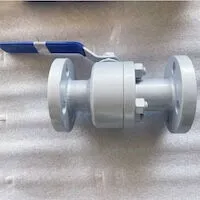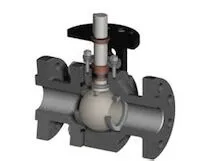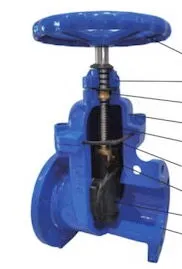Repair Welding of Common Valve Castings
Sep 12, 2023
1. Overview
In the pressure-bearing valves of industrial pipelines, cast steel valves are widely used because of their economy and design flexibility. However, because the casting process is restricted by the casting size, wall thickness, climate, raw materials and construction operations, various casting defects such as sand holes, holes, cracks, shrinkage porosity, shrinkage cavities and inclusions will appear in the castings, especially in alloy steel castings made by sand casting. The more alloying elements in the steel, the poorer the fluidity of molten steel becomes, and the more likely casting defects will occur. Therefore, it has become a common concern in the hot and cold processing of valves to identify defects and formulate a reasonable, economical, practical and reliable repair welding process to ensure that the valve after repair welding meets the requirements for quality. Repair welding methods and experience of several common steel casting defects are introduced in this article. The old grades are adopted for welding rods.
2. Handling defects
2.1. Defect judgment
In production practice, repair welding is not allowed for some casting defects, such as cracks, penetrating defects, honeycomb holes, sand and slag inclusions that cannot be removed, and shrinkage porosity with an area exceeding 65cm2, as well as other major defects not being able to be repaired as agreed in the contract. The type of defect should be judged before repair welding.
2.2. Removing defects
In the factory, carbon arc gouging is generally used to blow casting defects, and then a portable angle grinder is used to polish the defective parts until the metallic luster is exposed. However, in production practice, it is more likely to directly use carbon steel welding rods with high current to remove defects and use an angle grinder to obtain metallic luster. To remove general casting defects, use an electrode of less than 4mm-J422, and current 160 to 180A to remove the defects, and use an angle grinder to grind the defect, forming a U shape to reduce welding stress. Defects are removed thoroughly, and the repair welding quality is good.
2.3. Preheating of defective parts
For carbon steel and austenitic stainless steel castings with a repair welding area of less than 65cm2, a depth less than 20% or 25mm of the thickness of the casting, preheating is generally not required. However, for pearlitic steel castings such as ZG15Cr1Mo1V and ZGCr5Mo, cold welding is easy to crack due to the great hardening tendency of the steel, so it should be preheated. The preheating temperature is between 200 and 400℃. Repair welding with stainless steel electrodes should be adopted, and a small value should be used for the temperature. The holding time should not be less than 60 minutes. If the casting cannot be preheated as a whole, it can be heated to 300 to 350°C with oxygen-acetylene, extending 20mm at the defective part. Visually observe the dark red in the dark place, and the large-scale cutting torch neutral flame gun should be used to swing quickly in a circle for a few minutes at the defective part and its surroundings first, then change to slow movement and keep for 10 minutes, depending on the thickness of the defect, so that the defective part can be fully preheated, and then quickly repair welding can be performed.
3. Repair welding
See Table 1 for the current and electrodes used for repair welding.
Table 1 Current and electrode for repair welding
2. Handling defects
2.1. Defect judgment
In production practice, repair welding is not allowed for some casting defects, such as cracks, penetrating defects, honeycomb holes, sand and slag inclusions that cannot be removed, and shrinkage porosity with an area exceeding 65cm2, as well as other major defects not being able to be repaired as agreed in the contract. The type of defect should be judged before repair welding.
2.2. Removing defects
In the factory, carbon arc gouging is generally used to blow casting defects, and then a portable angle grinder is used to polish the defective parts until the metallic luster is exposed. However, in production practice, it is more likely to directly use carbon steel welding rods with high current to remove defects and use an angle grinder to obtain metallic luster. To remove general casting defects, use an electrode of less than 4mm-J422, and current 160 to 180A to remove the defects, and use an angle grinder to grind the defect, forming a U shape to reduce welding stress. Defects are removed thoroughly, and the repair welding quality is good.
2.3. Preheating of defective parts
For carbon steel and austenitic stainless steel castings with a repair welding area of less than 65cm2, a depth less than 20% or 25mm of the thickness of the casting, preheating is generally not required. However, for pearlitic steel castings such as ZG15Cr1Mo1V and ZGCr5Mo, cold welding is easy to crack due to the great hardening tendency of the steel, so it should be preheated. The preheating temperature is between 200 and 400℃. Repair welding with stainless steel electrodes should be adopted, and a small value should be used for the temperature. The holding time should not be less than 60 minutes. If the casting cannot be preheated as a whole, it can be heated to 300 to 350°C with oxygen-acetylene, extending 20mm at the defective part. Visually observe the dark red in the dark place, and the large-scale cutting torch neutral flame gun should be used to swing quickly in a circle for a few minutes at the defective part and its surroundings first, then change to slow movement and keep for 10 minutes, depending on the thickness of the defect, so that the defective part can be fully preheated, and then quickly repair welding can be performed.
3. Repair welding
See Table 1 for the current and electrodes used for repair welding.
Table 1 Current and electrode for repair welding
| Casting materials | Electrode grades | Electrode specifications/mm | Repair welding current/A | Type of welding current/A |
| Medium and low carbon steel castings such as ZG250 - 485, ZG205 - 415, WCA, WCB, WCC, etc. | J422 |
2.5 | 50 to 80 | AC and DC |
| A 102 | 3.2 | 100 to 130 | ||
| A 107 | 4.0 | 160 to 210 | ||
| A132 | 2.5 | 50 to 80 | A102, A132 AC and DC, A107 DC | |
| ZG15Cr1M olV# | R317 | 3.2 | 80 to 110 | |
| R327 | 4.0 | 110 to 150 | ||
| A 232 | 3.2 to 4.0 | 130 to 160 | DC reverse | |
| ZGCr5Mo# | R507 | |||
| A 402 | 3.2 to 4.0 | 90 to 150 | AC and DC | |
| A 407 | 3.2 to 4.0 | 130 to 160 | DC reverse | |
| A 102 | 3.2 to 4.0 | 90 to 150 | AC and DC | |
| A 107 | DC | |||
| ZG35CrMo | J607 | 3.2 to 4.0 | 140 to 200 | DC reverse |
Stainless steel welding rods are only suitable for castings where the depth of repair welding defects is less than 20% of the wall thickness.
3.1. Requirements
When repair welding austenitic stainless steel castings, it should be cooled rapidly in a ventilated place. For pearlitic low-alloy steel castings and carbon steel castings with excessively large repair welding areas, the leeward location or windshield should be used to avoid cracks caused by rapid cooling. For the repair welding of a build-up layer, the slags should be removed immediately after repair welding, and hammered outwards evenly along the center of the defect to reduce the repair welding stress. If the repair welding is carried out in several layers (generally, a repair welding layer with a thickness of 3 to 4mm). After each layer of repair welding, the slags should be removed in time. If welding is performed in winter, for ZG15Cr1Mo1V pearlitic alloy steel castings, each repair layer should be heated repeatedly with oxy-acetylene, and then repaired quickly to avoid welding cracks.
3.2. Electrode treatment
Before repair welding, first check whether the electrode is preheated. Generally, the electrode should be dried at temperatures from 150 to 250°C for 1 hour. The preheated welding rod should be placed in an incubator so that it can be taken as needed. The electrode is preheated repeatedly 3 times. If the coating on the surface of the electrode is peeled, cracked and rusted, it should not be used.
3.3 Repair welding times
For pressure-bearing castings, such as valve housings undergoing pressure testing and water seepage, the same part is generally only allowed to repair welding once, and repeated repair welding is not allowed, because repeated repair welding will cause coarse grains in the steel and affect the pressure-bearing performance of the casting. For repair welding the same non-pressure-bearing part, it is generally stipulated that repair welding shall not exceed 3 times. For carbon steel castings that have been repaired more than twice in the same position, stress relief treatment shall be performed after welding.
3.4. Heights of repair welding layers
The repair welding height of the casting is generally about 2mm higher than the plane of the casting to facilitate machining. If the repair welding layer is too low, it is easy to expose welding scars after machining. The repair welding layer is too high, time-consuming, labor-intensive and material-intensive.
Previous: Material Selection and Treatment of Hydrogen Peroxide Pipeline Ball Valves
Next: Valves Commonly Used in Chemical Production


